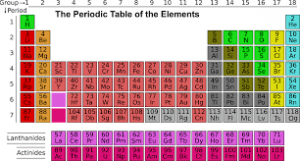In this installment of our series, we will continue to examine what I consider to be fallacious argumentation by Fazale Rana (better known as Fuz Rana) in his book, “Dinosaur Blood and the Age of the Earth.” Fuz Rana is an old-earth creationist and is a prominent member of the Reasons to Believe organization headed by Hugh Ross. Here we continue to examine Chapter 4, “How Did Soft Tissue Survive in Dinosaur Fossils?”–pages 53-72. (Previous articles of this series can be found here: Part 1, Part 2, Part 3, Part 4, Part 5A, Part 5B, Part 5C, Part 6.)
Chemical Kinetics
Fuz Rana is critical of creationist Brian Thomas regarding Thomas’ following statement in his article, “A Review of Original Tissue in Fossils and Their Age Implications.”
“ ‘If original tissues can avoid being processed by scavengers, microbes, or chemicals, they nevertheless fall apart according to universal entropy, which describes how systems that are left to themselves spontaneously disorganize over time.’ Thomas is, indeed, correct.”—pg. 66-67
Since Thomas is correct, what is the problem with Thomas’ assertion that the empirical science tells us that biomaterials cannot even last one million years let alone hundreds of millions of years? According to Rana, Thomas “[fails] to distinguish between thermodynamically controlled and kinetically controlled chemical reactions,” and that sufficient “energy of activation” may not exist in certain burial conditions to allow for the breakdown of those biomaterials.
The problem with Rana’s statement here is that molecules, and the basic elements and atoms that molecules are made of, are not static entities. Molecules break down over time due to the internal dynamics on the atomic level.
There is a lot of active energy and movement in the electron shell of an atom. The higher the temperature, the faster they move, but even at extremely low temperatures atoms are still in constant motion. To fall below the range of energy of activation for tissue decay would require conditions of practically zero degrees kelvin, or minus 459.67 degrees Fahrenheit! Thus, there is no avoiding entropy and the Second Law of Thermodynamics by this means, rendering Rana’s proposal fallacious.
Rana’s error consists partly in the portrayal of entropy as being put into effect solely through the action of external chemical agents. Entropy is not all due to “chemical reactions” as Rana seems to imply in his comments. Rana ought to be taking into account the role of physics in this phenomenon, as well as the role of chemistry.
The Arrhenius Equation

On page 68, Rana states:
“These calculations [that Thomas cites] made use of the Arrhenius equation. This equation allows scientists to calculate the rate of a chemical process (such as the breakdown of collagen) at any temperature, once the rate has been experimentally determined for a single temperature….
“One has to wonder if the kinetic data for collagen breakdown in bone near the boiling point of water is relevant to the breakdown rate for temperatures that would be under 100°F, let alone to temperatures near 50°F.”
The reader should note well that the Arrhenius equation is a well-established and well-tested protocol in science, used routinely for decades (see this Wikipedia entry, for example).
The Arrhenius equation is a part of empirical, repeatable, observational science—a routine protocol—which has been tested and proven reliable. The Arrhenius equation proves, for example, that the toughest of all biomaterial, collagen, will break down in less than a million years in the best case scenario under absolutely optimal conditions—conditions which probably do not exist anywhere in nature.
Even one million years is exceedingly much to realistically expect. And yet we have discoveries of biomaterials even from sub-Cambrian animals (the latest being cholesterol from sub-Cambrian animals erroneously presumed to be up to 571 million years old!) by evolutionist scientists.
To quote “Dr. J” (Dr. Charles Jackson): “No…chemical…way!”
From the foundation of the basic elements themselves, which can be understood in strict mathematical terms, to all of the untold thousands of molecules which exist, we live in a world of law not chaos. This is why we can have a science called “forensic pathology.” And this is why we can predict the breakdown of biomaterials over time.

The repeatable scientific experiments on living tissue decay demonstrate a predictable relationship between temperature and other factors and the decay of biomaterials. This is why we are able to confidently extrapolate out scenarios over long stretches of time; and this is why homicide detectives are able to say that a murder victim was murdered within a certain small window of time.
Rana Protests
Rana disputes the reliability of the Arrhenius equation (well, actually he disputes it only in the case of soft-tissue-containing fossils presumed to be millions of years old) and he does not provide so much as a smidgen of empirical science as support.
What Rana does do is go through a list of biologically produced materials such as collagen, keratin, chitin, etc. and make a “best foot forward” argument about the toughness and durability of these biomolecules. He also gives a list of burial conditions which he suggests could result in these materials being preserved for hundreds of millions of years (pgs. 55-66). It is important to note that this is all pure speculation.
Rana is engaging in special pleading here, that is to say, he is implicitly arguing that the known scientific laws governing biological tissue decay do not apply to extant dinosaur tissue in rock strata presumed to be tens or hundreds of millions of years old. Extant dinosaur tissue, etc., mysteriously gets a special exemption from the known laws of science.
Of relevance here is Mark Armitage’s reference to the books of forensic pathologist, Dr. Bill Bass, Death’s Acre, and Beyond the Body Farm in his video critiquing Mary Schweitzer’s blood iron experiments. See Armitage: Iron1, Iron 1B, Iron 2A
A Scientific Picture?
On page 71, Rana states:
“[I]t has taken (and is still taking) paleontologists time to explain how soft tissue remnants persisted in fossil remains for millions of years. While they haven’t solved the puzzle quite yet, they have discovered some important clues. And as a result, a beautiful ‘scientific’ picture is emerging.” (bold emp. sup.)

This admission is nothing if not understatement. The sober and realistic characterization of the state of affairs would be to say, “Scientists haven’t got a clue how preservation of biological materials could endure for millions of years, and we are nowhere close to solving the puzzle at any time in the foreseeable future.” That is the true state of affairs.
Rana does at least have the integrity to place appropriate quotation marks around the word “scientific,” because he knows very well that there is no actual scientific picture in this scenario he is suggesting (“scientific” in this case meaning observable, testable and repeatable experiments).
Special Pleading
In his concluding remarks in Chapter 4, on pages 71-72 Rana states:
“As I carefully consider the different mechanisms that researchers propose to account for soft tissue survival and as I have thought about this issue myself as a biochemist, I no longer find it difficult to believe that soft tissue fragments can survive for hundreds of millions of years.”
On What Authority?
In these words, Rana invokes his own authority as a biochemist as persuasion of his readers. But it is not Rana’s knowledge of biochemistry, thermodynamics and chemical kinetics which is driving his propositions and his conclusions. Rana admits as much.
Conclusion and Summary
The empirical demonstration of Rana’s proposition that biological materials can last hundreds of millions of years does not exist, and in fact Rana’s proposal is contradicted by the empirical data, a fact which Rana acknowledges.
It is, rather, Rana’s commitment to old-earth theology which is the driving force behind his conclusion here. That would be fine by me if Rana would just plainly say so. The fact is that the empirical science is simply not there to back up Rana’s hypothesis, though you certainly get the opposite impression reading his book.
When all is said and done, extant biomaterials from mistakenly-supposed 65 million year old Tyrannosaurus rex remains and, even more astonishingly, supposed 571 million year old sub-Cambrian animals, is overwhelmingly powerful scientific testimony that the fossil record is only thousands of years old, not millions. That means the rock strata they are found in are also only thousands of years old…and all that that implies.
This is Rana’s “beautiful scientific picture that is emerging.” To my mind, this makes extant biomaterials of dinosaurs and other organisms the premier scientific issue of our time.
Featured Image, “Adam et Ève au Paradis Terrestre” (“Adam and Eve in the Earthly Paradise”) by Wenzel Peter, painted sometime between 1800 – 1829.








A major mistake that Dr. Rana made was not understanding the difference between the denaturation point of bone collagen and that of skin/muscle collagen. In response to my challenge to provide experimental support for his assertion of the error of thermal kinetic studies vs. “real” world decay, he found a paper discussing the denaturation point of muscle collagen. However, the denaturation point of bone collagen is far higher than that of muscle collagen, so bone collagen is not subject to the type of chemical alteration that Rana suggests has happened in the thermal kinetic studies. Thus, one of Dr. Rana’s major conclusions is clearly in error.
See: https://answersingenesis.org/dinosaurs/bones/are-dinosaur-proteins-virtually-immortal/
Thank you, Dr. Anderson, for weighing in here on this pivotal point. Touché! I quoted you from another Answers in Genesis article in my March 17, 2017 article here on this site: https://thecreationclub.com/dinosaur-blood-and-the-real-age-of-the-earth-part-3/, in what I thought was a most penetrating and another pivotal answer to Rana. And worth citing again to our interested readers: “In his book Dinosaur Blood, Dr. Fazale Rana questions the validity of these decay studies since the researchers measured degradation rates only at high temperatures. He concludes that because high temperatures will accelerate protein degradation, these studies cannot be applied to decay rates in cooler, subsurface environments.
“However, Dr. Rana completely misrepresents these experiments. High temperatures are often used in protein decay studies to assure a rapid degradation, since lower temperatures can dramatically slow the rate of decay. This slower decay could extend the length of the experiment by months or even years. As long as the protein decay rate fits a predictable reaction curve, the Arrhenius equation can be used for converting the rate to different temperatures. Therefore, decay measured at high temperatures can be used to predict the decay rates at lower temperatures. This is a common protocol in protein biochemistry, and is well established with decades of experimental work.
“Dr. Rana speculates that high temperatures may unexpectedly alter how collagen will degrade, so perhaps the Arrhenius equation cannot be properly applied. However, he fails to offer any experimental support for his conclusion. If he wants to challenge these decay studies, he needs to provide experimental evidence that collagen decay is somehow an exception to this equation. Since the decay rates are well established, he would have a distinct ‘uphill battle,’ which might explain why he only offers conjecture as his rebuttal to the experimental work.
“Plus, as already mentioned, in addition to collagen, fragments of many other proteins have been extracted from dinosaur fossils. Several of these proteins (e.g., myosin, actin, and tropomyosin) are not nearly as structurally “tough” as collagen. In fact, studies would suggest some of these proteins degrade fairly rapidly postmortem. Thus, there is no experimental evidence that each of these other proteins could survive for more than just a fraction of the time that collagen can survive. Even if there were a biochemical basis that enabled collagen fragments to survive millions of years, this cannot be said about all these other dinosaur proteins.”—Answers in Genesis website, “Dinosaur Tissue: A Biochemical Challenge to the Evolutionary Timescale,” by Dr. Kevin Anderson on October 20, 2016, bold emph supp.